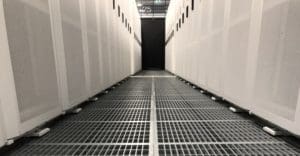Server room cooling is crucial for maintaining optimal performance and longevity of your IT infrastructure. At EziBlank, we understand the challenges posed by excess heat in server environments, which is why we’ve developed innovative air-flow management solutions designed to maximise efficiency and reduce energy consumption. Our cutting-edge blanking panels not only enhance cooling effectiveness but also ensure that your vital equipment operates at peak performance. Don't let overheating compromise your technology; choose EziBlank to elevate your server room's climate control today.
Everything you need to know about a Server Room
A server room is a specialised space designed to house computer servers and related equipment, playing a critical role in managing and supporting an organisation's IT infrastructure. These rooms are meticulously controlled environments where temperature, humidity, and airflow are carefully managed to ensure optimal performance and longevity of the servers. Key elements of a server room include server racks for organising hardware, cooling systems to prevent overheating, uninterruptible power supplies (UPS) for continuous power, and robust security measures to protect sensitive data. Proper planning and management of a server room are essential for maintaining the reliability and efficiency of the IT systems that businesses rely on daily.
Read More
Airflow Management Products
Airflow management products are essential tools for optimising cooling efficiency and maintaining the performance of data centres. These products include blanking panels, which are used to cover unused spaces in server racks, preventing hot air from recirculating and ensuring that cool air is directed precisely where it’s needed. Perforated floor tiles are another key product, allowing controlled cool air delivery from beneath the raised floor to the servers. Additionally, air curtains and containment systems, such as hot and cold aisle containment solutions, help separate hot and cold air streams, further enhancing cooling efficiency. By implementing these airflow management products, data centres can reduce energy consumption, improve equipment longevity, and maintain optimal operating conditions.
Read More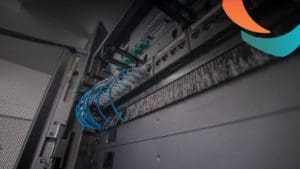
Data Center Cooling: Best Practices
Implementing best practices for data centre cooling is crucial to maintaining efficiency, reducing energy costs, and ensuring the longevity of equipment. Key practices include optimising airflow by using blanking panels to fill unused rack spaces, which prevents hot air recirculation and ensures that cool air reaches the servers effectively. Additionally, employing hot and cold aisle containment systems can further enhance cooling efficiency by separating hot exhaust air from cold intake air, reducing the workload on cooling systems. Regular maintenance of HVAC systems and air filters is essential to ensure that cooling units operate at peak performance. Monitoring temperature and humidity levels in real-time allows for adjustments that prevent overheating and ensure optimal conditions. By following these best practices, data centres can achieve significant improvements in cooling efficiency, leading to lower operational costs and improved equipment performance.
Read More
Hot Aisle Containment Solutions & Products
Hot aisle containment solutions typically include barriers, doors, and ceiling panels that effectively seal off the hot aisle, creating a controlled environment where the separation of hot and cold air is meticulously maintained. This separation ensures that hot exhaust air is directed away from the servers and into return air ducts, preventing it from mixing with the cool intake air and thereby enhancing the efficiency of the cooling system. Implementing these solutions not only significantly reduces energy consumption and lowers cooling costs but also enhances the overall performance, reliability, and lifespan of the data centre’s infrastructure, making it a vital strategy for modern data centres aiming to optimise their operations.
Read More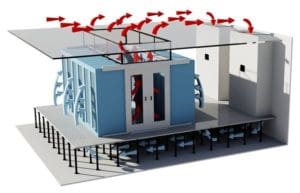
How to Manage Airflow in a Data Center
Managing airflow in a data centre is crucial for maintaining optimal cooling efficiency and ensuring the longevity of equipment. Effective airflow management begins with the strategic placement of blanking panels in server racks to eliminate gaps, which prevents hot air from recirculating and ensures that cool air is directed precisely where it’s needed. Implementing hot and cold aisle containment systems further enhances airflow by separating the hot exhaust air from the cool intake air, reducing the workload on cooling systems. Proper cable management is also essential to avoid obstructions that can disrupt airflow patterns. Additionally, using perforated floor tiles in the raised floor environment helps channel cool air directly to the servers. Regular monitoring and adjustments based on real-time data are necessary to maintain efficient airflow and adapt to changes in the data centre’s layout or load. These strategies collectively help optimise cooling, reduce energy consumption, and improve the overall performance of the data centre.
Read More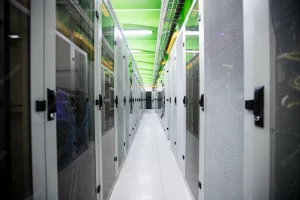
What is Cold Aisle Containment
Cold aisle containment is a data centre cooling strategy designed to improve energy efficiency and optimise temperature control. In this setup, the cold aisle, where the fronts of the server racks are located, is enclosed to prevent the mixing of cold air with the hot exhaust air from the servers. This containment system ensures that the cool air from the air conditioning units is directed exclusively towards the servers' intake, maximising cooling efficiency. By containing the cold aisle, data centres can maintain lower temperatures with less energy, reducing the workload on cooling systems and lowering overall energy consumption. This approach not only improves the performance and reliability of the equipment but also contributes to significant cost savings and a more sustainable data centre operation. Cold aisle containment is particularly effective in high-density data centres where cooling demands are substantial.
Read MoreThe 411 on CRAC Units
Computer Room Air Conditioning (CRAC) units are essential components in data centre cooling systems, designed to maintain optimal temperature and humidity levels for sensitive IT equipment. These units work by drawing warm air from the data centre, cooling it, and then distributing the chilled air back into the room, ensuring that servers and other hardware operate within safe temperature ranges. CRAC units often feature precise controls to maintain consistent environmental conditions, which is crucial for preventing overheating and ensuring the longevity of equipment. Incorporating CRAC units into a data centre's cooling strategy, along with effective airflow management techniques like blanking panels and aisle containment, helps improve overall cooling efficiency and reduce energy consumption.
Read More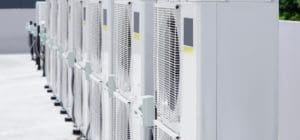
What is Hot Aisle Containment
Hot aisle containment is a cooling strategy used in data centres to improve energy efficiency by isolating the hot air generated by servers. In this setup, the hot aisle, where the backs of the servers expel warm air, is enclosed, preventing the hot air from mixing with the cool air in the rest of the data centre. This containment ensures that the hot air is directed straight to the cooling units, where it is removed or recycled, thereby reducing the workload on the cooling system. By maintaining a clear separation between hot and cold airflows, hot aisle containment helps to lower energy consumption, enhance cooling efficiency, and maintain optimal operating conditions for the servers, making it a crucial strategy for modern data centre management.
Read More
The Basics of Airflow Management
Airflow management is a fundamental aspect of data centre design that focuses on optimising the cooling process to ensure that IT equipment operates efficiently and reliably. The primary goal is to prevent the mixing of hot and cold air within the data centre, which can lead to hotspots and inefficient cooling. Key strategies include the use of blanking panels to seal off unused rack spaces, directing cool air to where it’s needed most and preventing hot air from recirculating. Additionally, hot and cold aisle containment systems are employed to physically separate the cold intake air from the hot exhaust air, further improving cooling efficiency. Effective airflow management reduces the energy required for cooling, lowers operational costs, and enhances the overall performance and lifespan of data centre equipment.
Read More
High performance directional floor tiles for high density equipment racks
High-performance directional floor tiles are a critical component in data centre design, specifically engineered to optimise airflow and cooling efficiency. These tiles are strategically placed within raised floor systems to direct cool air from the underfloor plenum towards the server racks, ensuring that the air reaches the equipment that needs it most. By guiding airflow precisely, directional floor tiles help maintain consistent temperatures across the data centre, prevent hotspots, and reduce the workload on cooling systems. This leads to more efficient cooling, lower energy consumption, and improved overall performance of the data centre. Incorporating these tiles into a data centre's design is an effective way to enhance both energy efficiency and operational reliability.
Read More